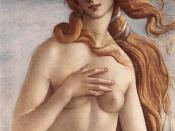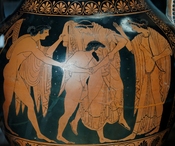The Greek goddess Leto was indeed transformed as the Romans adapted her to "Latona". Although she kept her general characterization, some personifications are different in her Roman equivalent. Through myth, the duties and purposes she was responsible for, the symbols that represented her, etymology, and through genealogy, the two civilizations that worshipped her molded her into a supreme deity. In the modern age, her spirit, of both Greek and Roman origin, lives unconsciously in the minds of mothers and all other people alike. All of these aspects tie in with the fact that she was a loving and beautiful mother, and even the Romans recognized that feature and did not change it.
The myths involved with Leto and Latona always talked of some sort of persecution. Lycia, a culture that admired Greece, was the civilization who seemed to worship Leto the most. Lycia's most important sanctuary was that of the cult of Letoon - a cult worshiping the triune gods of Leto and her children, Artemis and Apollo.
The preceding Greek myth that originated in Lycia tells of the goddess Leto. This story tells that while Leto was fleeing from the wrath of Hera, farmers in Lycia refused to let her drink from a fountain near the river Xanthos. In her anger, she pleaded with the heavens, which she had been banned from by Hera, to turn them into frogs. Looking for a place to bath her children and quench her thirst, a wolf then guided her to the Xanthos River, where she bathed her children and thankfully named the country Lycia ("Lykos" means wolf). Ovid also wrote a rendition of the tale, addressing her as Latona (Atsma). However, in his Metamorphases, he excluded the end of the original story, when a wolf relieves Leto by leading her...


